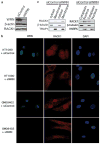Depletion of WRN protein causes RACK1 to activate several protein kinase C isoforms
- PMID: 19966859
- PMCID: PMC4586175
- DOI: 10.1038/onc.2009.443
Depletion of WRN protein causes RACK1 to activate several protein kinase C isoforms
Abstract
Werner's syndrome (WS) is a rare autosomal disease characterized by the premature onset of several age-associated pathologies. The protein defective in patients with WS (WRN) is a helicase/exonuclease involved in DNA repair, replication, transcription and telomere maintenance. In this study, we show that a knock down of the WRN protein in normal human fibroblasts induces phosphorylation and activation of several protein kinase C (PKC) enzymes. Using a tandem affinity purification strategy, we found that WRN physically and functionally interacts with receptor for activated C-kinase 1 (RACK1), a highly conserved anchoring protein involved in various biological processes, such as cell growth and proliferation. RACK1 binds strongly to the RQC domain of WRN and weakly to its acidic repeat region. Purified RACK1 has no impact on the helicase activity of WRN, but selectively inhibits WRN exonuclease activity in vitro. Interestingly, knocking down RACK1 increased the cellular frequency of DNA breaks. Depletion of the WRN protein in return caused a fraction of nuclear RACK1 to translocate out of the nucleus to bind and activate PKCdelta and PKCbetaII in the membrane fraction of cells. In contrast, different DNA-damaging treatments known to activate PKCs did not induce RACK1/PKCs association in cells. Overall, our results indicate that a depletion of the WRN protein in normal fibroblasts causes the activation of several PKCs through translocation and association of RACK1 with such kinases.
Conflict of interest statement
The authors declare no conflict of interest.
Figures








Similar articles
-
The Werner syndrome gene product (WRN): a repressor of hypoxia-inducible factor-1 activity.Exp Cell Res. 2012 Aug 15;318(14):1620-32. doi: 10.1016/j.yexcr.2012.04.010. Epub 2012 May 31. Exp Cell Res. 2012. PMID: 22659133
-
Werner protein cooperates with the XRCC4-DNA ligase IV complex in end-processing.Biochemistry. 2008 Jul 15;47(28):7548-56. doi: 10.1021/bi702325t. Epub 2008 Jun 18. Biochemistry. 2008. PMID: 18558713 Free PMC article.
-
The Werner syndrome protein affects the expression of genes involved in adipogenesis and inflammation in addition to cell cycle and DNA damage responses.Cell Cycle. 2009 Jul 1;8(13):2080-92. doi: 10.4161/cc.8.13.8925. Epub 2009 Jul 5. Cell Cycle. 2009. PMID: 19502800
-
Role of Werner syndrome gene product helicase in carcinogenesis and in resistance to genotoxins by cancer cells.Cancer Sci. 2008 May;99(5):843-8. doi: 10.1111/j.1349-7006.2008.00778.x. Epub 2008 Feb 26. Cancer Sci. 2008. PMID: 18312465 Free PMC article. Review.
-
The Werner's Syndrome RecQ helicase/exonuclease at the nexus of cancer and aging.Hawaii Med J. 2011 Mar;70(3):52-5. Hawaii Med J. 2011. PMID: 21365542 Free PMC article. Review.
Cited by
-
Expression profiling of mouse embryonic fibroblasts with a deletion in the helicase domain of the Werner Syndrome gene homologue treated with hydrogen peroxide.BMC Genomics. 2010 Feb 22;11:127. doi: 10.1186/1471-2164-11-127. BMC Genomics. 2010. PMID: 20175907 Free PMC article.
-
The Werner syndrome helicase protein is required for cell proliferation, immortalization, and tumorigenesis in Scaffold attachment factor B1 deficient mice.Aging (Albany NY). 2011 Mar;3(3):277-90. doi: 10.18632/aging.100300. Aging (Albany NY). 2011. PMID: 21464516 Free PMC article.
-
RACK1 is evolutionary conserved in satellite stem cell activation and adult skeletal muscle regeneration.Cell Death Discov. 2022 Nov 18;8(1):459. doi: 10.1038/s41420-022-01250-8. Cell Death Discov. 2022. PMID: 36396939 Free PMC article.
-
RACK1 promotes the development and function of alveolar macrophages through directly binding to and stabilizing PPARγ.Proc Natl Acad Sci U S A. 2025 Jun 17;122(24):e2421672122. doi: 10.1073/pnas.2421672122. Epub 2025 Jun 13. Proc Natl Acad Sci U S A. 2025. PMID: 40512793
-
Diabetes-induced increased oxidative stress in cardiomyocytes is sustained by a positive feedback loop involving Rho kinase and PKCβ2.Am J Physiol Heart Circ Physiol. 2012 Oct 15;303(8):H989-H1000. doi: 10.1152/ajpheart.00416.2012. Epub 2012 Aug 3. Am J Physiol Heart Circ Physiol. 2012. PMID: 22865386 Free PMC article.
References
-
- Battaini F, Pascale A, Paoletti R, Govoni S. The role of anchoring protein RACK1 in PKC activation in the ageing rat brain. Trends Neurosci. 1997;20:410–415. - PubMed
-
- Beckman KB, Ames BN. The free radical theory of aging matures. Physiol Rev. 1998;78:547–581. - PubMed
-
- Berns H, Humar R, Hengerer B, Kiefer FN, Battegay EJ. RACK1 is up-regulated in angiogenesis and human carcinomas. FASEB J. 2000;14:2549–5258. - PubMed
-
- Besson A, Wilson TL, Yong VW. The anchoring protein RACK1 links protein kinase Cepsilon to integrin beta chains. Requirements for adhesion and motility. J Biol Chem. 2002;277:22073–22084. - PubMed
Publication types
MeSH terms
Substances
Grants and funding
LinkOut - more resources
Full Text Sources

